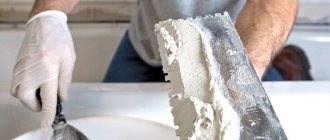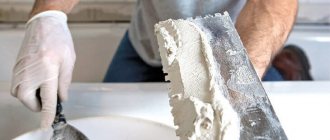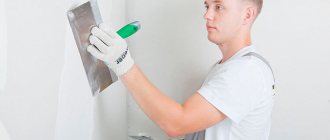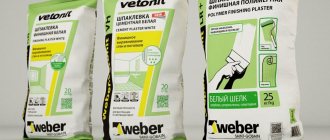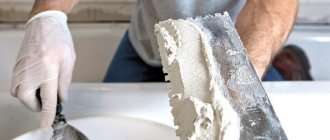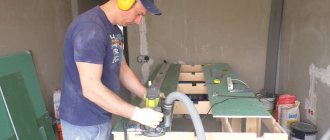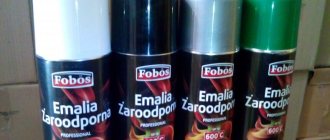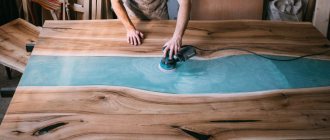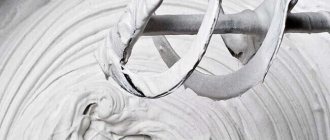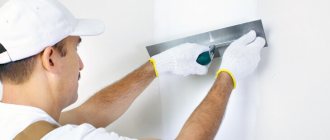When you are thinking about renovating your home, many questions always arise. For example, how to install drywall correctly, whether you can do it yourself, whether it needs to be primed, and what putty to buy. The drywall itself is smooth and even, but it comes in certain sizes, so it is impossible to avoid joints between them. These irregularities, as well as the visible screw heads, must be sealed with putty.
This work is not difficult, but it takes a lot of time. First you need to decide on the putty. Putty is a white powder-like substance that is used in construction. Using this material, smooth walls, floors and ceilings are created. You can apply paint or wallpaper over the dried putty.
Repairing holes in drywall ceilings
The technology for constructing a frame for large holes in drywall is the same for both vertical and horizontal surfaces.
Therefore, novice craftsmen will not have the question of how to repair a hole in the drywall on the ceiling. If you don’t have a drill and a screwdriver at hand, but you still have a bottle of construction foam left over from the repair, you can use it to fill the hole in the ceiling and form a stable base. Before filling the hole with foam, it is necessary to clean the inner edges of dust to ensure adhesion of the foam to the underside of the drywall. After hardening, the foam is cut flush with the plane and puttied. The method works on fragments up to 15 cm or at a short distance to the rough ceiling.
When repairing ceiling defects caused by soaking of gypsum boards, it is worth remembering that the ceiling should be thoroughly dried before starting work. Otherwise, mold will grow under the drywall, which has a devastating effect on health.
The listed methods are not the only possible ones. After all, drywall is a universal material that can work in conjunction with a wide variety of mixtures and solutions. How to repair a hole in a plasterboard wall? - ingenuity and imagination will prompt the home craftsman with his own ideas that will work just as well.
Let's sum it up
Now you know how to putty problem areas on plasterboard structures. You can learn more interesting things from the video in this article. Questions can be asked in your comments.
Did you like the article? Subscribe to our Yandex.Zen channel
June 8, 2022
Plasterboard systems, Construction Chemicals, Plaster and wall putty
If you want to express gratitude, add a clarification or objection, or ask the author something, add a comment or say thank you!
How to seal seams in drywall: materials used
Let's start by looking at the question of what cannot be used to solve the problem of how to seal drywall joints? Quite often, many craftsmen use for these purposes not very suitable materials, which seem to be able to be used if they were not distinguished by their weak ability to adhere to the surface in a thick layer. I’ll say it a little differently - they can be used, but the technology in this case will take a considerable amount of time. Such materials should be applied in thin layers, after allowing them to dry completely. Such materials include finishing putty of all stripes.
To seal drywall seams, only two types of materials are used - a reinforcing mesh called serpyanka, and a special glue. Let's talk about these materials in a little more detail.
- Adhesive for drywall joints. A prominent representative of the materials in this group is a dry construction mixture called “Fugenfüller” - adhesive compositions similar to it are adapted in such a way that they do not crack during the drying process, no matter how quickly they dry and no matter how thick a layer they are applied. They can only be replaced with glue for installing drywall on the surface - they hold the joint perfectly, but working with them is not very convenient due to their viscosity and high hardening speed. As an option, some craftsmen use mixtures for starting putty to solve the problem of how to putty plasterboard seams - in principle, they hold the joint, but subject to the correct manufacture of the frame, the correct sewing of plasterboard sheets and, in general, full compliance with all the subtleties and nuances of working with structures from plasterboard.
- Serpyanka is an auxiliary reinforcing tape for drywall seams. It does not help if the frame is weak or incorrectly made - it is also of little use if installed incorrectly. What is sickle tape? This is a mesh made from modern synthetic materials - exactly the same as is used for plastering polystyrene foam, only it is implemented with a narrow tape. Recently, solid tape made from special paper has appeared on sale - let's face it, the option is not a very good one for one reason. It is simply glued to the joint, over which glue is subsequently applied - it does not strengthen the seam and, in principle, does not weaken it. In general, there is practically no sense from it.
There are practically no options here - if you want to make the drywall joint reliable, durable and non-cracking, use serpyanka and special glue. How to use them? But this is what we will talk about next.
Preparation of the solution
Water is poured into a small container, then the dry mixture is gradually added. It is added until “islands” of dry putty appear on the surface.
Then the mixture should be saturated with water, for this it is left for 5 - 10 minutes.
The mixture must be stirred again to break up any lumps.
Criteria for choosing putty
Before starting a renovation, many people wonder what putty to choose for drywall? According to the method of use, the product is divided into two types:
- Starter or basic. Serves to level out significant unevenness and differences of up to 20 mm. The resulting rough layer has a rough surface and is the basis for applying another, higher quality coating. In case of sudden changes, the starting putty is applied in several stages, each subsequent layer is applied on top of the previous one only after it has completely dried. The product easily absorbs moisture, so it can be prepared very quickly by diluting it with water.
- Finish. Used for higher quality finishing on small differences (up to 5mm). It is also diluted with water. If the defects are minor and do not require the use of drywall starting putty, in this case the finishing material can be applied to the surface after pre-treating the area with a primer.
Considering that the plasterboard sheet is perfectly flat, the starting putty is practically not used, but the finishing putty is used.
Types by type of binder
This building material is also divided according to its composition. Depending on the conditions in which you have to work and the type of room, choose the following types of putties:
- Gypsum has the finest structure; it is often assigned the role of finishing. It absorbs moisture well, so it is not recommended for use in damp basements and places where the moisture content in the air is too high.
- Cement. In places with high moisture content, it is better to use a product on this basis. Putty is more resistant to such conditions, has high strength and a long service life.
- Polymer. It is mainly used for treating ceilings.
Each type of mixture has its own advantages and disadvantages, so you should carefully approach the purchase of material and the question of what putty to putty on drywall.
Review of manufacturers
There are currently several major brands on the market.
Knauf
A popular manufacturer producing high-quality mixtures. To seal joints the following are used:
- "Fugen". Includes three groups of solutions: universal, ordinary and moisture-resistant. The seam is covered in 2 layers, the thickness of each is 1–3 mm. The composition contains gypsum and special modifiers responsible for plasticity. During site preparation, priming is mandatory.
- "Uniflot". This mixture from Knauf outperforms other types. Suitable for puttying any edges, it is waterproof and elastic, which prevents cracking. Naturally, such parameters increase the cost.
Among Knauf products intended for working with plasterboard, the Uniflot mixture has proven itself best, but when purchasing putty you should be careful, as fakes are often found
Volma
A fairly common option, characterized by a reasonable price and good quality. The mixture consists of gypsum and various fillers. It has excellent adhesion, taking into account the composition's lifetime of 35–40 minutes.
For work with drywall and gypsum boards, a variety marked “Seam” is used. The process involves mandatory priming of the joint and thorough drying. Laying is done in two layers followed by sanding.
A specialized mixture for joints is good because the joint does not need to be reinforced, but in dry rooms you can use standard compounds, which are much cheaper, and for rooms with high humidity there is a special putty
Prospectors
To seal the gaps between the slabs, a finishing variety is used. A special feature of the product is the need for installation in dry rooms with stable humidity. The mixture contains gypsum and polymer additives. Available in the form of a dry substance, the solution is suitable for use within 50 minutes. The manufacturer indicates the possibility of laying a thick layer, but it is recommended to divide the process into two stages with mandatory preparation.
Dry mixes from the Starateli brand have a good price-quality ratio, but the short setting time will be a problem for the home craftsman
Vetonit
A universal variety that is also suitable for sealing joints in objects with constant humidity. Due to the fact that polymer glue acts as a binder, it is possible to achieve excellent adhesion, but this increases the drying time (at least a day).
To work with drywall, a superplastic dry mixture and ready-made putty for painting are usually used; the second option is easier to work with.
Sheetrock
The products of this manufacturer are highly reliable. For DIY work, a polymer variation is used, which can be dry or ready-made, depending on the group. Excellent for damp rooms, drying time – 24 hours.
High-quality polymer putty from Sheetrock
For puttying, it is better to purchase compounds that have been recently manufactured.
Methods for puttingtying drywall seams with tape
Depending on the depth and width of the seams and their locations (horizontal, vertical, corner - internal and external), various methods of sealing (puttying) drywall seams are used, such as single-layer and double-layer putty, using reinforcement mesh (serpyanka) or paper perforated tape, perforated metal or plastic corners.
It is necessary to prepare all the necessary tools and materials.
Tools and materials used for sealing drywall joints
- - container (bucket) and mixer (drill) - for preparing and stirring putty;
- - roller and cuvette - for applying primer;
- - deep penetration primer - to improve the adhesion of the putty to the base;
- — serpyanka and/or perforated tape for reinforcing seams;
- — special putty for joints;
- - construction knife;
- — a set of spatulas for applying and leveling putty;
- - a grater with a set of meshes, or sandpaper for sanding putty surfaces.
Sequence of preparatory work
- — clean the seam from debris and dust;
- - treating drywall seams with a primer for better adhesion of the putty to the base;
- — preparing seams for putty;
- — applying the first layer of putty;
- — application of reinforcing mesh (serpyanka) or perforated paper tape;
- - embedding sickle or tape into the first layer of putty using a spatula;
- — applying, if necessary, a second, finishing layer of putty;
- - sanding putty areas.
Sealing drywall joints
Inspection of edge condition
This is the first step in sealing drywall joints. In the process of manufacturing various structures, plasterboard sheets have to be cut, which means the appearance of smooth rectangular edges. Sealing the joints of such edges is not easy.
For high-quality sealing of seams, it is necessary to make chamfers along the cut line. The chamfers should be about fifty millimeters wide and made at an angle of 45°. In this case, the joint will take a V-shape, the angle will be 90°. This manipulation is mandatory; it allows for improved adhesion of the putty to the drywall. The same should be done if the edge of the drywall sheet differs from the factory one and has chips, cuts, or plaster is visible.
Priming surfaces before puttying
Before puttying, it is necessary to treat the surfaces of the plasterboard sheets with a primer. The locations of seams, joints, abutments and corners require special care in priming. One of the most popular and frequently used primers for drywall is Knauf Tiefengrunt. It is designed specifically for highly absorbent surfaces.
Having primed the entire surface, you must wait until it dries completely, then apply the primer again to the joints. By doing this carefully, you will reduce the consumption of putty.
Primer functions:
- — improves adhesion (adhesion) of two materials. As a result, when puttying, the likelihood of blistering and material peeling is reduced.
- — equalizes absorbency. The result is a reduction in material consumption during the puttying process and a leveled surface. Therefore, it is not recommended to skip the primer application step.
You can apply primer to drywall using any method suitable for you - with a brush, roller, sprayer. However, make sure that the application is even and that the layer thickness is at least 0.05 millimeters.
Puttying drywall seams
After the soil has completely dried on the surface of the drywall, you can proceed to the next operation - filling the joints. This stage of work includes:
- - prepare a mixture for sealing joints;
- - cover the screw heads with putty;
- - apply an excessive amount of putty to the joints so that it penetrates deep;
- - Fill the entire length of the seam with putty.
- - fill the seam space as much as possible with a spatula;
- - Use a spatula to carefully remove excess mixture from the wall and let it dry.
Putties for sealing seams
Construction tapes for puttying drywall joints
A special tape is designed for high-quality strengthening of joints. To treat drywall joints, it is optimal to use special tapes:
Serpyanka for putty
It is a fiberglass mesh. Convenient to use. As a rule, it is self-adhesive. Suitable for longitudinal joints. It is not recommended to use for transverse joints, especially susceptible to cracking. Suitable for seams of any width and length, because... has standard sizes.
Paper tape
This tape is reinforced with fiberglass and has a special fold in the middle (to facilitate puttying corners). Gives a very strong reinforced connection.
Surface preparation
Before starting putty work, it is necessary to carry out preparatory work to clean the surface:
- All protruding screws and nails must be tightened or driven into the surface with a hammer.
- Next, you need to process the seams using chamfers, preferably before installing corrugated sheets. Sometimes it is necessary to cut the edges at a 45-degree angle with a paint knife.
- Remove dust and dirt and apply a primer mixture.
- When the primer has dried, proceed to the next stage of finishing work.
How to seal
Sealing joints on a plasterboard surface involves 3 steps:
- Purchasing materials and assembling a set of tools.
- Preparing the seam for reinforcement.
- Step-by-step plan for completing the work.
To reinforce joints you will need a set of tools:
- brush;
- putty knife;
- a clean container for diluting the mixture;
- construction knife with a sharp blade.
- Sandpaper.
Materials needed:
- primer;
- reinforcing mixture;
- reinforcing tape, corner (aluminum corner profile PU 25x25);
- clean water at room temperature;
- mixture for joints.
All tools and containers must be clean. Working with a dirty tool is difficult and does not give the expected results.
There are several options for reinforcing tape:
- Serpyanka is similar to a medical bandage and is durable due to its composition.
- Paper - manufacturer KNAUF. When wet, it does not lose its properties.
- Non-woven - contains fiberglass.
- Tape with a metal insert - used to reinforce the corners of gypsum boards.
After collecting everything you need, you can begin preparatory work with the joint. It consists of several steps:
- The seams must be chamfered and clean. Use a brush to clean the border of the sheets from dust, and carefully remove small pebbles of plaster.
- Cover the seams with a clean brush and primer mixture. This must be done carefully so that the primer fits well into the seam. The corners of the plasterboard structure are also treated.
- You need to give the primer mixture time to dry.
After drying the joint, the main work begins.
To do this, dilute the mixture for reinforcing joints according to the instructions on the package. Mostly they buy Knauf Fugen.
Next, using a medium-sized spatula, apply a thin layer of the mixture to the joint. Glue the tape on top so that it lies centered along the seam. Using a clean spatula, press it slightly into the damp putty on top, thereby collecting the excess.
The next step is to cover the tape with the same mixture. Without waiting for it to dry.
The remaining putty is used to cover the fasteners. The caps of the screws are “recessed” into the drywall by 1 mm. All areas are treated with primer.
Self-adhesive sickle tape is fixed to the plasterboard surface without putty. After gluing, it is covered with a putty mixture.
How to cover seams
KNAUF Uniflot mixture is used for sealing joints without reinforcing tape. Its differences:
- The strength of putty is comparable to cement.
- It is light in weight, so it is used on plasterboard surfaces.
- The putty does not allow or absorb water.
The diluted solution is applied to the joint in one layer. If there is a gap of 2 mm between the plasterboard sheets, then apply 2 layers. Work with the mixture for 25 minutes, after which it hardens.
If you intend to hang a heavy object on a wall made of GC sheets, then the craftsmen recommend using Knauf paper tape with this putty to make the structure more durable.
Another putty mixture is JS weber vetonit. It is a polymer composition that has a strong adhesion to the plasterboard surface.
The principle of operation is the same as with KNAUF UNIFLOT. However, craftsmen do not recommend using putty mixtures without reinforcing tape.
Sizing with serpyanka in the corners of plasterboard walls
The corners of the plasterboard structure are carefully reinforced, since they bear a large load.
Internal corners may become deformed due to building subsidence.
External corners are subject to mechanical stress (impacts).
Before applying serpyanka to the inner corner, it is cleaned of dust and thoroughly treated with a primer.
Using the mixture to reinforce the joints, glue the serpyanka and cover the top with putty.
Serpyanka is used in small corners - created niches, podiums, shelves. To reinforce the internal corner from the ceiling to the floor in the room, use a tape with a metal insert.
The outer corner is best protected with a perforated corner corner. Putty is applied to the cleaned, primed corner. They put a corner on it and “sink” it in well. From above, without drying out, the corner is covered with the mixture. Everything should dry out. This will take no more than 10 hours.
Using paper tape to seal joints on drywall
Paper tape for drywall seams is produced by many manufacturers, but the high quality of the Knauf brand is noted. For the production of reinforcing tape, high-quality raw materials are used, which are durable. Sealing drywall joints is a simple, but important task.
Do not forget that the strength of the entire structure depends on this. Video on sealing drywall seams with paper tape. Knauf paper tape for drywall is a high-quality material: the tape is laced with fiberglass throughout the entire strip. The paper tape is a little rough to the touch. This is done for better adhesion to putty. When creating plasterboard structures, joints appear on the ceiling and walls - the boundary between two sheets. The joint should be properly sealed, this serves as the strength of the entire structure. Paper drywall tape is one of many materials designed for such purposes.
You should also choose a putty that will last a long time. This is what paper tape for sealing drywall seams looks like. There are the following materials on the market for sealing drywall seams:
- It perfectly reinforces the seams, creating structural strength.
- The tape does not break after getting wet.
- It allows air to pass through well.
- Not toxic to humans and animals.
This is how it is best to design the outer corner at the joints of drywall sheets, BUT, under the metal corner it is best to glue paper tape for gypsum board joints to the corner, if the surface is to be painted, if under wallpaper, you can do that. It is better to attach metal corners to putty/plaster, first coating the corner with it, and then fixing the corner. In the photo they are screwed on with self-tapping screws, which spoils the corner a little and can warp it, which will affect the quality of the finish. We unstitched the seams, primed them, and the primer dried.
It is better to seal the seams with a special putty for gypsum board joints, for example Fugenfuller (FUGEN) from Knauf. You can also use regular plaster mixed with a deep penetration primer; this method can also be suitable if you plan to putty drywall, since the plaster has a large fraction. There are some subtleties here. If you are diluting the mixture in large quantities, say, you will be processing a large volume of surface and you have a lot of workers, then when using a construction mixer for mixing, do not use high speeds. This method involves a lot of additional air in the composition, and its excessive amount has a bad effect on the strength of the final product.
Sanding the areas we need is done with regular sandpaper, an abrasive mesh, which is fixed to a special block, or a special abrasive grater. What to choose - decide for yourself.
- The material is affordable.
- Due to its minimal thickness, it can be used for strengthening even ready-made surfaces.
- It goes well with putty and drywall, practically becoming one with them after drying. This gives the seam special strength.
Serpyanka is sometimes called a construction bandage: they are really very similar. It is a thin fiberglass mesh, one side of which is coated with a special adhesive composition. It should be stored in a bag to prevent the glue from drying out. Sealing the spaces between the sheets is carried out before starting plastering work.
Most often, fiberglass mesh is mounted on longitudinal seams. The technology for using serpyanka is as follows: In practice, for finishing work using gypsum boards, two types of reinforcing materials are used for reinforcement and sealing - paper tape for drywall seams and serpyanka. What's the difference between them?
Additional information on the topic:
- How to decorate a plasterboard partition in a room
- How much will a room shrink when covered with plasterboard?
- At what distance should I place hangers on the ceiling for plasterboard?
- Which is better, plasterboard or OSB for interior partitions?
- What is better to use plasterboard or gypsum fiber in the bathroom?
How to seal drywall joints. The working process
Drywall joints are most often sealed using classical technology using serpyanka. But first, it is necessary to carry out preparatory work.
Drafts should be eliminated by closing windows and doors. The first step is to press on the space between the sheets of drywall. If this area is flimsy, there is no point in sealing the seams, since light pressure on the material after finishing will cause cracks to appear on the surface.
Before sealing the joints, the surface to be treated must be cleaned of construction dust. Excess material in the form of glue is removed. Make sure that the joints between sheets of drywall have indentations. When preparing drywall for wallpaper, you need to make sure that the heads of the mechanical fasteners are slightly recessed into the material. If they protrude above the surface, this defect should be eliminated.
Before sealing joints, you need to check whether there is a chamfer in the place where the drywall sheets are connected into a seam. You need to chamfer yourself if you don’t have one. In the absence of end processing of the canvases, it is necessary to perform jointing. Damaged elements are removed with a construction knife.
When sealing the seams between sheets of plasterboard on the ceiling, you need to make sure that the coating is firmly held. Otherwise, it is additionally fixed. After this work, a primer is applied to the surface of the drywall. When sealing joints in the seam area, the mixture is applied with a brush, because if this work is done with a roller, there is no guarantee that the composition will get into the seams. The primer is applied to the joints with a deviation of 15 cm from the seam to the left and to the right.
Now you can prepare putty for sealing drywall joints. The mixture should be left for some time so that its components begin to interact with each other. Do not dilute too much mixture. Now you can apply a layer of putty, picking up the material with a spatula. It is necessary to completely fill the border of the seam.
After this, the serpyanka is used, which is applied on top. The material is laid at the joint between the sheets of drywall so that the tape is distributed evenly on both sides of the seam. The seal involves embedding the tape in a layer of putty. You need to apply another layer of the mixture on top. The seams between the plasterboard sheets should not protrude too much above the surface.
Using a spatula, the composition is leveled over the base. In order to make sure that the wall is level, after sealing the joint, you need to apply a building level to the drywall. As soon as the putty has dried, you should sand it a little with sandpaper.
How and with what to seal seams on drywall: rules for choosing the tools necessary for operation
No grouting is complete without such an essential tool as a spatula. Each master chooses for work a spatula that is convenient for him. Some people find it easier to seal seams with a narrow tool, while others find it easier to seal seams with a wide one. That's not the point
The most important rule to consider when choosing a spatula is the flexibility of the blade. The advantages of a tool with a flexible blade are ease of processing hard-to-reach places
Many craftsmen use only finishing to seal seams. Of course, when treating the joints with a finishing putty mixture, the work will be completed much faster, but then there is a risk of huge gaps forming between the sheets of drywall.
To ensure a very strong connection between the joints, it is better to use special types of putty. This is especially true in cases where the surface of the plasterboard sheet will subsequently be painted. If you plan to cover the surface of the plasterboard sheet with paint, the seams should be filled with a special solution intended for this purpose.
Today, there are two types of putties used for grouting joints:
- Universal – start and finish.
- Special ones, the basis of which is alpha gypsum. Among the most famous brands, I would like to note the gypsum putty Rotband from the Knauf company.
In addition to the spatula and putty, you should take care of purchasing:
- Paper tapes or reinforced mesh used for gluing seams;
- An electric drill equipped with a special attachment designed for stirring the putty mixture;
- Special containers needed for preparing putty;
- Corner. The sealing of joints will be of better quality;
- Sandpaper. It will be useful for sanding seams.
If you plan to cover the drywall with wallpaper, then there will be plenty of starting or finishing putty, since the texture of the wallpaper can cover small defects on the walls.
Video: puttying joints of gypsum board sheets with a cut edge
Guest. Welter. It is necessary to describe the technology and then explain it with illustrations. And here are pictures that are used to try to describe the technology, but the description of the pictures is done incorrectly.
Dmitriy. I have long planned to make a suspended ceiling, but I wanted it with high-quality sound insulation. I chose slabs made of padding polyester. I traveled to different companies. In some places the slabs are greenish, in others they are prickly, in others the density is low. I wanted it to contain no phenol. I chose MaxForte EcoAcoustic. The material met all requirements. The slabs are white, odorless, with optimal density. EcoAcoustic secured everything to the ceiling with dowels. Installation is simple: the slabs do not generate dust or itch, unlike mineral wool. The master then stretched the ceiling. I'm happy with the result, I got a beautiful stretch ceiling with excellent and most importantly environmentally friendly sound insulation.
Elena. The very detailed manual turned out to be useful, some of the tiles have already been laid, it turns out great, now it’s a matter of technique, as they say, thank you.
oxana. Thank you for the article! Quite simple and useful recommendations. The first time I decided to putty the ceiling myself. It turned out pretty good. I generally like this site. All your articles here are great! I will recommend him to my friends and acquaintances.
Types of putties
For plastering, various types of putty are used, designed for certain conditions. There are several groups of building mixtures.
Cement
They are in greatest demand and are available in most hardware stores or supermarkets. Their advantages:
- high strength;
- moisture resistance;
- affordable price;
- Application does not require special tools or skills.
At the same time, they shrink significantly over time and do not contribute to maintaining a favorable microclimate in the living space, so they are rarely used in houses and apartments. An exception is plastering kitchens and bathrooms.
Plaster
They are also very popular because they have high adhesion to the base. They set quickly, harden, and are easy to process. Using various additives, you can change the properties of the mixture or color, which significantly expands the possibilities of its use.
Application of gypsum plasterSource myshtukaturka.ru
Disadvantage: low resistance to dampness and humidity. Even the inclusion of hydrophobic impurities does not fundamentally change the situation, so gypsum compositions are not used when finishing kitchens, bathrooms and other similar premises.
Acrylic
Such compositions are made on the basis of polymer materials. They are noticeably more expensive than their analogues, but also have excellent performance characteristics. Like cement mixtures, they have increased strength and resistance to moisture. The relief texture of the finished surface allows you to create an attractive design.
Another advantage of acrylic putty is its high resistance to mechanical damage. The material easily retains its structure under the influence of various factors and can withstand prolonged use for several decades.
Handling uneven sheet edges
If the sheet has been cut or broken and then trimmed along the edge, it must be prepared before use. Why, how and why - we will answer further.
If you pay attention, at the edges of all gypsum sheets, you can notice a rounding, or a decrease in the thickness of the sheet. This was done for a reason, but for a very specific purpose - sealing sheet joints
Putty is applied to the recess that is created by connecting two sheets with the edges when leveling. It forms an even and strong layer if it “extends” a little over the sheet area, and is not just located at the joint itself. To make such a recess, you need to prepare cut plasterboard parts.
It's very simple - you need a drywall plane or a sharp knife. Either one or the other, you need to chamfer along the edge of the part at an angle of 45 degrees.
Now, if you place such a part against another, even with a factory edge, a recess will be formed, which will be filled with putty mixture during alignment, and as a result, the seam will be stronger.
Compound
Manufacturers add the following components to the silicone mixture:
- liquid potassium glass;
- silicone resins;
- marble chips;
- titanium dioxide.
Acrylic putty is made on the basis of:
- water;
- acrylates;
- plasticizers;
- modifiers.
How to properly putty drywall seams: putty and tape for puttying joints (video)
Puttying plasterboard joints is necessary to add strength to the weak points of the plasterboard structure, obtain a uniform surface and maintain its attractive appearance. Without such treatment, the following problems may arise over time: You can see how to putty seams at the joints of drywall sheets in the video. The notes tell you how to putty correctly, what is the best mixture to choose for this, and whether it is possible to do this work yourself.
Serpyanka can be glued before puttying. In this case, the surface is thoroughly cleaned of dust, and a mesh is glued to the joints. When gluing it, you need to press it tightly so that there are no folds.
Putty for seams must be applied over the serpyanka, pressing the material into the mesh cells with a flexible spatula and spreading it over the entire length of the seam in a thin, uniform layer.
- What humidity will be in the room? Putty for drywall joints based on gypsum, intended for dry rooms, will peel off in wet rooms.
- What will be the finishing coat applied to drywall? Different types of mixture can be applied under wallpaper and for painting. In the second case, it is better to prefer polymer putty.
Proven specialized putties that can be selected for initial processing (sealing) of seams: “Knauf Fugen”, “Knauf Uniflott”, “Volma SHOV”.
Conclusion
Which putty to choose for drywall is probably the most frequently asked question among novice finishers, and the answer is not as simple as it seems at first glance. To get a quality drywall finish, thoroughly research the options on the market. It is worth purchasing material in accordance with the tasks set, the type of premises and your financial capabilities.
Each of the types of putty described above has its own distinctive characteristics. In any case, you should not save on purchasing finishing materials - choose products from well-known brands such as Vetonit, Volma, Fugenfüller.
